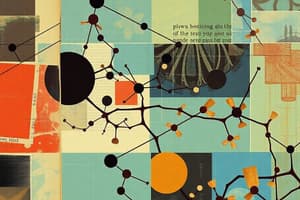Podcast
Questions and Answers
What is the drug concentration which achieves 50% of the maximum effect called?
What is the drug concentration which achieves 50% of the maximum effect called?
- Potency
- Affinity
- EC50 (correct)
- Emax
Which drug has the highest affinity according to the given text?
Which drug has the highest affinity according to the given text?
- Codeine
- Adrenaline
- Morphine
- Fentanyl (correct)
What type of drug binds to the receptor but does not cause a cellular response?
What type of drug binds to the receptor but does not cause a cellular response?
- Inverse agonist
- Full agonist
- Antagonist (correct)
- Partial agonist
What happens to the efficacy of a full agonist when combined with a noncompetitive antagonist?
What happens to the efficacy of a full agonist when combined with a noncompetitive antagonist?
According to the given text, what is the factor affecting affinity?
According to the given text, what is the factor affecting affinity?
What is the mathematical relationship that defines the dissociation constant (Kd)?
What is the mathematical relationship that defines the dissociation constant (Kd)?
What determines the concentration of a drug around the receptor needed to form a certain number of drug-receptor complexes?
What determines the concentration of a drug around the receptor needed to form a certain number of drug-receptor complexes?
What follows the law of mass action in drug-receptor interaction?
What follows the law of mass action in drug-receptor interaction?
What is the capacity to activate a receptor called in drug-receptor interaction?
What is the capacity to activate a receptor called in drug-receptor interaction?
What determines the fraction of receptors at each state during equilibrium in drug-receptor interaction?
What determines the fraction of receptors at each state during equilibrium in drug-receptor interaction?
What determines the fraction of receptors at each state during equilibrium in drug-receptor interaction?
What determines the fraction of receptors at each state during equilibrium in drug-receptor interaction?
What is the mathematical relationship that defines the dissociation constant (Kd)?
What is the mathematical relationship that defines the dissociation constant (Kd)?
Which factor affects the drug affinity in drug-receptor interaction?
Which factor affects the drug affinity in drug-receptor interaction?
What happens to the efficacy of a full agonist when combined with a competitive antagonist?
What happens to the efficacy of a full agonist when combined with a competitive antagonist?
What type of drug binds to the receptor but does not cause a cellular response?
What type of drug binds to the receptor but does not cause a cellular response?
What is the effect of a competitive antagonist on the dose-response curve of a full agonist?
What is the effect of a competitive antagonist on the dose-response curve of a full agonist?
Which drug is an example of a partial agonist acting as an antagonist in the presence of an agonist?
Which drug is an example of a partial agonist acting as an antagonist in the presence of an agonist?
What determines the maximal efficacy of a partial agonist?
What determines the maximal efficacy of a partial agonist?
What is the main difference between a competitive and a noncompetitive antagonist?
What is the main difference between a competitive and a noncompetitive antagonist?
What is the effect of a noncompetitive antagonist on the efficacy of a full agonist?
What is the effect of a noncompetitive antagonist on the efficacy of a full agonist?
Flashcards are hidden until you start studying
Study Notes
Drug-Receptor Interaction
- The drug concentration that achieves 50% of the maximum effect is called EC50.
Types of Drugs
- A drug that binds to the receptor but does not cause a cellular response is called an antagonist.
- A partial agonist is a drug that binds to the receptor and causes a cellular response, but with lower efficacy than a full agonist.
- An example of a partial agonist acting as an antagonist in the presence of an agonist is the drug buspirone.
Affinity and Dissociation Constant
- The factor affecting affinity is the strength of binding between the drug and the receptor.
- The mathematical relationship that defines the dissociation constant (Kd) is Kd = [R] [D] / [RD], where [R] is the concentration of receptors, [D] is the concentration of drug, and [RD] is the concentration of drug-receptor complexes.
Receptor Binding
- The concentration of a drug around the receptor needed to form a certain number of drug-receptor complexes is determined by the law of mass action.
- The law of mass action states that the rate of a reaction is proportional to the concentrations of the reactants.
Receptor Activation
- The capacity to activate a receptor is called efficacy.
- The fraction of receptors at each state during equilibrium is determined by the affinity and efficacy of the drug.
Antagonists
- A competitive antagonist increases the EC50 of a full agonist, shifting the dose-response curve to the right.
- A noncompetitive antagonist decreases the efficacy of a full agonist, without changing the EC50.
- The main difference between a competitive and a noncompetitive antagonist is that competitive antagonists bind to the same receptor as the agonist, while noncompetitive antagonists bind to an allosteric site.
Studying That Suits You
Use AI to generate personalized quizzes and flashcards to suit your learning preferences.




